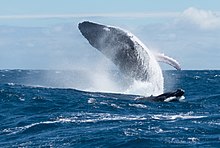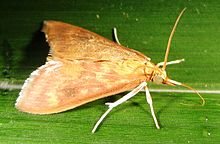User:RosieLillian/sandbox
Various Experiments Involving the Investigation of Zoomusicology
[edit]Mammals
[edit]
Snowden and Teie performed an experiment on Cotton-top tamarins, Saguinus oedipus, to determine if music would lead to behavioural changes, and whether music made by other species would elicit similar behavioural responses as the music of one’s own species. [1] This experiment involved two separate categories of music - one was affiliation-based, the other was fear/threat-based music. Within the two categories, the experimenter varied whether the music was produced by humans or tamarins.[1] During the experiment, a baseline behaviour measurement was established, proceeded by the experimental condition, which was a piece of music that was played for 30 seconds. Following this, behaviour was analyzed for a total of 5 minutes. This analysis was made by an observer who was unaware of the true hypothesis of the experiment, and simply noted different behaviours which they had witnessed.[1] The experimenters found that the Tamarins altered their behaviour specifically when listening to Tamarin music. For example, when music from the affiliation condition was played, the behavioural response of the tamarins involved a decrease in overall movement and an increase in both social and foraging behaviour.[1] This contrasted the behaviour observed when the fear/threat based music was played. During this condition, the Tamarins were more likely to move around and show anxiety-based behaviour, as well as, an increase in social behaviour similar to that seen in the affiliation condition. It should also be noted that while the Tamarins did not show behavioural changes to human music as clearly as they did to their species-specific music, there was some behavioural change.[1] The Tamarins showed decreased movement when listening to human fear/threat based music and a decrease in anxious behaviour when listening to human affiliation music. This experiment, demonstrates that music is capable of eliciting changes in the behaviour of animals, most especially when the music is species-specific.[1]

Humpback whales, Megaptera novaeangliae, are capable of the production of complex songs.[2] These songs are amongst some of the longest measured in animals. Only male humpback whales perform these vocalizations; it was initially hypothesized that these songs may be a part of the sexual selection process. This point however, is unclear. It has been found that males only began their song after joining a group where pairs of mother and calf were present.[3] Although the reason behind this behaviour is uncertain, some have hypothesized that the songs produced by male humpback whales may be a part of escorting, or accompanying females. It should also be noted that singing can be a costly behaviour, because it can lead to more attention being drawn. In the humpback whales’ situation, their singing can attract other competing males.[3] Yet, the singing behaviour continues and therefore, it is assumed that the songs are critical to the courtship behaviour of the humpback whales.
Birds
[edit]
Perhaps the most well-known form of music found in non-human animals is birdsong.[4] Birdsong is different from normal calls. For example, a call will usually simply function to communicate a direct message.[4] For instance, a bird call could be used to direct attention that a predator is near. Meanwhile a song contains more repetition and usually will have distinct structure to it, with a specific beginning, middle, and end.[4] In many species of songbirds, songs seem to be used both as a way to attract potential mates, as well as to mark and defend one's territory. It has been observed that young songbirds acquire their ability to produce song from imitation of adult birds.[4] Interestingly enough, there seems to be a critical period for song learning. In one experiment, they compared birds raised in isolation, (this involved isolation from other birds as well as the vocalizations of other birds), with those raised in a colony, without these forms of isolation.[4] Using an fMRI scan and the blood oxygen level dependent (BOLD) as a measurement of brain activity, it was found that birds raised in the isolation condition did not appear to show a preference between their own songs and a repetitive song. Meanwhile colony-raised birds showed a stronger reaction to their own song being played back.[4]
Insects
[edit]
One potential barrier in the study of zoomusicology is that there are some forms of music produced by various animals which humans are incapable of hearing.[5] This music is very low in amplitude and is known as quiet song, whisper communication, or soft song.[5] This low amplitude music has been shown in birds, as well as insects and is linked to behaviour. Moth species have been shown to have developed the ability to communicate using ultrasonic sounds, and this ability has transferred over to their production of soft songs. In the Asian corn borer moth, Ostrinia furnacalis, males produce an ultrasonic soft song to initiate courtship behaviour.[5] The song that the male produces is so quiet that the female must be within a range of three centimeters in order to hear the song. In hearing the song, the female stays in one place and is completely still, this allows the male to initiate mating behaviour.[5] The reason that the female remains still, is because this song sounds very similar to sounds that a bat would produce. The female therefore remains still in order to avoid potential predation. There is of course another added benefit to this soft song produced by the male Asian corn borer moth, and that is that the song is so quiet that it decreases the males’ predation risk.[5] Although these soft songs are far less well-known to the general public, they are an important aspect of zoomusicology and the further understanding of animal behaviour.
citation I hope to use for adding to the Zoomusicology article:
[edit]Doolittle, E., Gingras, B. (2015). Zoomusicology. Current Biology, 25, 819-820. https://doi.org/10.1016/j.cub.2015.06.039
Rothenberg, D., Roeske, T., Voss, H., Naguib, M., Tchernichovsky, O. (2014). Investigation of musicality in birdsong. Hearing Research, 308, 71-83. https://doi.org/10.1016/j.heares.2013.08.016
Rothenberg, D. (2008) To wail with a whale anatomy of an interspecies duet. Transcultural Music Review, 12 https://www.sibetrans.com/trans/articulo/97/to-wail-with-a-whale-anatomy-of-an-interspecies-duet
Snowden, C., Teie, D. (2010). Affective responses in tamarins elicited by species-specific music. Biology Letters, 6, 30-32. doi: 10.1098/rsbl.2009.0593
Citation Practice:
It seems that mate selection can be seen in the peafowl population.[6] It appears as though peahens will choose to mate more often with males who have traits of colourful blue-green eye spots. Peacocks with less colourful plumage, or who do not have those specific colours displayed, have decreased rates of copulation compared to others with these traits.
Peer Review of Zoomusicology Article by User Rseward13
[edit]RosieLillian,
Firstly, I think the behaviour of zoomusicology is a fascinating one, and I was pleased to read about it in species from distantly related taxa. The fact that you included examples of research from mammals, birds and even invertebrates such as the Asian corn borer moth provides good context as to the evolutionary maintenance of song throughout the animal kingdom. As for the writing of the article itself, I think it is well written. One detail I noticed in the "Birds" subheading is when you refer to research conducted by Rothenberg et al with respect to birdsong, you said " In one experiment, they compared birds raised in isolation", rather than "Rothenberg et al conducted research" or "researchers performed experiments". Just one little thing I noticed that might make that specific citation a little less ambiguous.
I noticed that Zoomusicology is an article that you are adding to rather than starting from scratch, so with respect to developing a lead section that is easy to understand, I understand that this is not necessary. The definition of zoomusicology is already on the Wikipedia page of this topic, although I noticed that whoever originally did this did not put any references to their sources so that might be something you've already considered or want to consider adding.
The structure of your article is indeed clear, and you have maintained a consistent theme in choosing a specific taxa of animals and discussing species that seem to have definitive and reliable research that has been completed in order to better understand this behaviour/variety of musical behaviours. Your citations are consistent throughout each section and there certainly did not appear to be any plagiarism (accidental!!). The sources you have are all from reliable and well respected journals (Animal Behaviour, Behavioural Ecology, etc.) and therefore come from an unbiased, scientific source.
I believe overall your article is well done, well cited and unbiased. This was an interesting read!
 | This is a user sandbox of RosieLillian. You can use it for testing or practicing edits. This is not the sandbox where you should draft your assigned article for a dashboard.wikiedu.org course. To find the right sandbox for your assignment, visit your Dashboard course page and follow the Sandbox Draft link for your assigned article in the My Articles section. |
Article Evaluation
Article: Mating
This article presented many points which appeared to be relevant to the topic of mating. The definition of mating was a very inclusive one and covered numerous forms of mating in various species. Information seems to be up to date, however, I feel that since they mentioned animal artificial insemination (in their commentary on animal husbandry), they could have also mentioned In-Vitro Fertilization and surrogacy for humans that are unable to conceive.
This article maintained a neutral tone throughout and did not appear to reflect any bias. This neutral tone enabled the reader to remain focused on the explanation of mating from an impartial perspective.
It appears as though the links are working for the sources, and the sources support what is being stated in the article. These sources also appear to be unbiased, as the majority are coming from scientific journals, which can be accessible to the public for source checking.
The talk page included many comments. One comment that I found particularly interesting, indicated that there is confusion around whether the definition of mating is simply the physical act, or whether it was the act of finding a mate. Something in which I agree, needs clarification within the article. Another comment mentioned that there were some details omitted, for example, there seemed to be some confusion regarding the reproduction of plants and the inclusion of this in the definition provided of mating. It was not overly clear whether plants were actually included in the definition of mating, yet there was a separate section on plant mating in the article. This could cause some confusion for the reader.
The article is rated as priority three, and there are two wikiprojects interested, Wikiproject Animals and Wikiproject Sexology and Sexuality.
- ^ a b c d e f Snowdon, Charles T.; Teie, David (2010-02-23). "Affective responses in tamarins elicited by species-specific music". Biology Letters. 6 (1): 30–32. doi:10.1098/rsbl.2009.0593. ISSN 1744-9561. PMC 2817256. PMID 19726444.
{{cite journal}}: CS1 maint: PMC format (link) - ^ "TRANS - Revista Transcultural de Música - Transcultural Music Review". www.sibetrans.com (in Spanish). Retrieved 2018-10-24.
- ^ a b Smith, Joshua N.; Goldizen, Anne W.; Dunlop, Rebecca A.; Noad, Michael J. (2008-08). "Songs of male humpback whales, Megaptera novaeangliae, are involved in intersexual interactions". Animal Behaviour. 76 (2): 467–477. doi:10.1016/j.anbehav.2008.02.013. ISSN 0003-3472.
{{cite journal}}: Check date values in:|date=(help) - ^ a b c d e f Rothenberg, David; Roeske, Tina C.; Voss, Henning U.; Naguib, Marc; Tchernichovski, Ofer (2014-02). "Investigation of musicality in birdsong". Hearing Research. 308: 71–83. doi:10.1016/j.heares.2013.08.016. ISSN 0378-5955. PMC 3947120. PMID 24036130.
{{cite journal}}: Check date values in:|date=(help)CS1 maint: PMC format (link) - ^ a b c d e Balenger, Susan L. (2015-07). "Stridulated soft song by singing insects". Animal Behaviour. 105: 275–280. doi:10.1016/j.anbehav.2015.03.024. ISSN 0003-3472.
{{cite journal}}: Check date values in:|date=(help) - ^ Dakin, Roslyn; Montgomerie, Robert (2013). "Eye for an eyespot: how iridescent plumage ocelli influence peacock mating success". Behavioral Ecology. 24 (5): 1048–1057. doi:10.1093/beheco/art045. ISSN 1465-7279.
